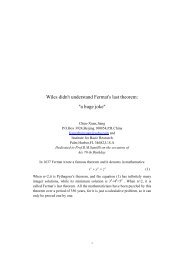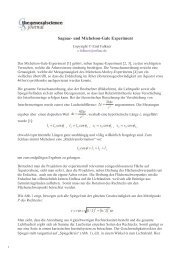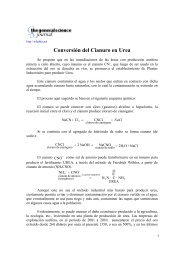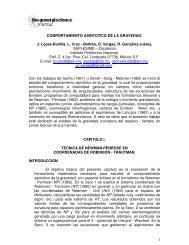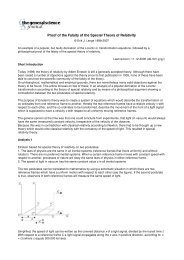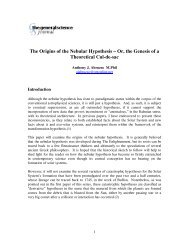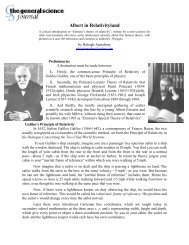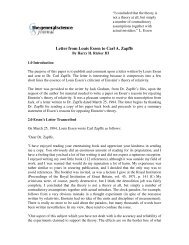MAGNETISM DURING THE SEVENTEENTH CENTURY HH Ricker III
MAGNETISM DURING THE SEVENTEENTH CENTURY HH Ricker III
MAGNETISM DURING THE SEVENTEENTH CENTURY HH Ricker III
Create successful ePaper yourself
Turn your PDF publications into a flip-book with our unique Google optimized e-Paper software.
projections allowed the particles to travel only in one direction. The filaments lying flat or<br />
ruffling up and blocking passage in the opposite direction. 24<br />
In Amsterdam in 1687, Joachim Dalencé published a book titled Traité de l’Aiman or Treatise on<br />
the Magnet. This gives a fine summary of magnetic knowledge of the seventeenth century.<br />
Dalencé was a French astronomer and physicist. The book gives a theory to explain the<br />
experiments on the magnetization of iron and steel. Dalencé returns to the Cartesian conception<br />
of pores lined with filamentary projections but discards the screw shaped particles. Delancé<br />
conceived a steel knife blade presented to the pole of a strong magnet. The force of the magnetic<br />
particles issuing from the magnetic pole would cause the projecting filaments or tiny hairs within<br />
the pores of the steel to lie flat. This “stroking action” of the magnetic particles disposed the steel<br />
pores to receive additional magnetic matter from the magnet, a process that resulted in the steel<br />
becoming magnetized. 24<br />
Following the manner of Descartes, Dalencé conceived streams of magnetic matter circulating<br />
through the earth from pole to pole, and then after exiting, flowing around outside the earth,<br />
entering at the poles again. The pores of the earth were conceived as running parallel with its<br />
axis of rotation and equipped with the bristly filaments, “garnished with little hairs” as Dalencé<br />
says, just as in iron and steel. The same idea was applied to the loadstone. The theory was<br />
adapted by Dalencé to explain why the iron caps or armoring of a loadstone increased its<br />
attractive force:<br />
“The magnetic matter on leaving the pole [of the loadstone] finds the pores of the iron<br />
pole piece so disposed as to facilitate its movement; it therefore passes through the iron cap<br />
easily, without being dissipated in any way. Thus the magnetic matter, being united, and in<br />
greater quanity, has more power to enter another piece of iron than it had on issuing from the<br />
uncapped pole of the loadstone.” 25<br />
The theory was also applied to the explanation of why a loadstone or magnetized iron and steel<br />
suffers, “the entire loss of force and virtue.” when heated in a fire. This occurred because:<br />
“the heat having changed the configuration of its parts and pores in a manner such that<br />
the magnetic matter can no longer pass through it... They are nevertheless capable of being again<br />
magnetized, the fire having changed neither the pores nor the configuration of the iron parts,<br />
which have remained elongated and suitable for giving passage, as before, to the magnetic<br />
matter.” 26<br />
Although the heat of the fire destroys the alignment of the pores of the material, this does not<br />
cause a permanent change in their alignment after the material cools down. A result that seems<br />
strange and unbelievable. The magnetization of forged iron, when beaten to prolong its length,<br />
was explained as caused by the fact that the magnetic matter meets less resistance if it travels<br />
along the grain of the beaten iron than in the other directions. Here, Dalencé seems to be saying<br />
that, beating iron to lengthen it in a certain direction, causes its pores to align in this direction.<br />
The explanations offered by Dalencé illustrate the advantages and disadvantages of the Cartesian<br />
approach to magnetism. The mechanism of the circulating magnetic matter and pores in iron and



